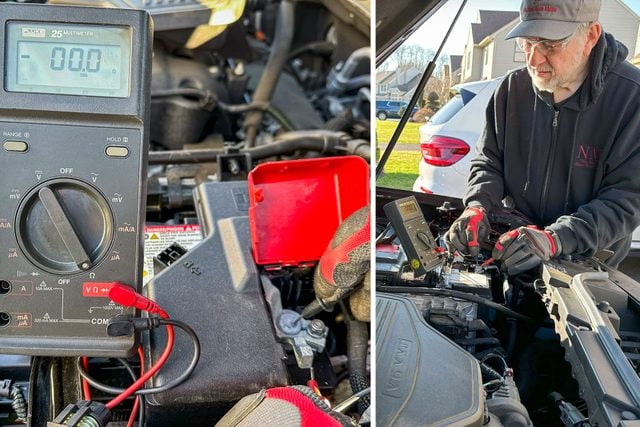If your car cranks over slowly or the battery terminals are corroded or cracked, it's time to replace the terminal ends.
1 hour
Beginner
$40-$60
Introduction
Over my 50 years in the auto repair industry, I've repaired hundreds, if not thousands, of battery cable terminals. But one particularly troublesome situation stands out.
Once while I was charging a battery, the cable clamps became blazing hot. After disconnecting the charger and letting everything cool down, I removed the battery cables, thinking the battery must have internally shorted.
The negative cable, which you always remove first, was fine. However, to my surprise, I found the inside of the positive cable completely corroded and battery post eroded. This kept electricity from flowing into the battery, causing the overheated charger clamps.
I told the customer to replace the battery and the battery terminals, but unfortunately the damage was already done. Due to extreme voltage and amperage surges, the engine control module (ECM) and the electronic air conditioner display/control panel failed within six months.
Corroded battery terminals can cause more problems than just difficulty starting. Although the corrosion buildup you see on a battery terminal is bad, the corrosion you don't see can be even worse.
Even minor corrosion between the inside of the battery terminal and the battery post can reduce alternator output and lower available voltage to the starter motor. That can stress your starter motor and charging system and cause early failures of other sensitive electronics our cars depend on.
What causes corrosion on car batteries?
Hydrogen gas from sulfuric acid released from a lead-acid battery mixing with moisture and road salts causes a chemical reaction that corrodes battery terminals.
If the battery terminals are in good shape and just dirty, you can clean them yourself. However, if they're damaged, pitted or rotted, or you cannot securely tighten the clamping nuts, it's time to replace them.
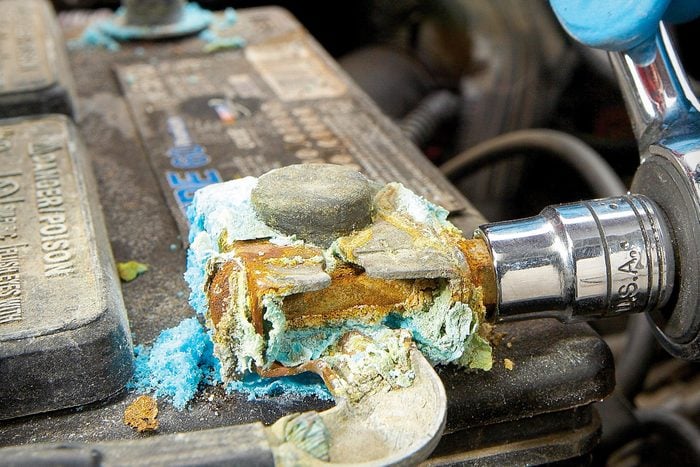
How much does it cost to replace car battery terminals?
Depending on where you live, around $130. If you DIY, you'll save a hour's labor charge (according to AAA $47-$215 an hour), the normal 25 percent markup on parts and materials, plus hazardous waste disposal fees.
What safety precautions should I take?
A battery contains sulfuric acid, which can cause serious burns. Always wear gloves and eye protection when working around a battery or jump-starting a car. If you come into direct contact with battery acid, flush with plenty of water and seek medical attention immediately.
How can I identify which car battery terminal is positive or negative?
According to Jon Stull, a National Institute for Auto Safety Excellence (ASE) master technician, look for the positive (+) and negative (-) markings on battery itself. The positive cable should be red or have a red cover. The negative cable should be black or have a black cover.
I find dirty cables confusing to identify. Cleaning the battery should expose the markings. If you're still unsure, use an inexpensive digital volt ohm meter (DVOM) determine which is which.
If you connect the positive lead of the DVOM to the positive battery terminal, and the negative lead to the negative battery terminal, the DVOM should display the battery voltage, around 12.6V. If the DVOM displays a negative (-) symbol in front of the battery voltage reading, you've connected it backwards. Either way, you now know how to proceed.
Which battery terminal do you disconnect first, red or black?
- Always disconnect the negative (-) black battery terminal first.
- Always reconnect the negative (-) black cable last.

When to call a pro
Replacing battery terminal ends is a basic DIY project. However, know your skill limits. If you don't feel comfortable working around a battery or don't have the proper tools, call a professional.
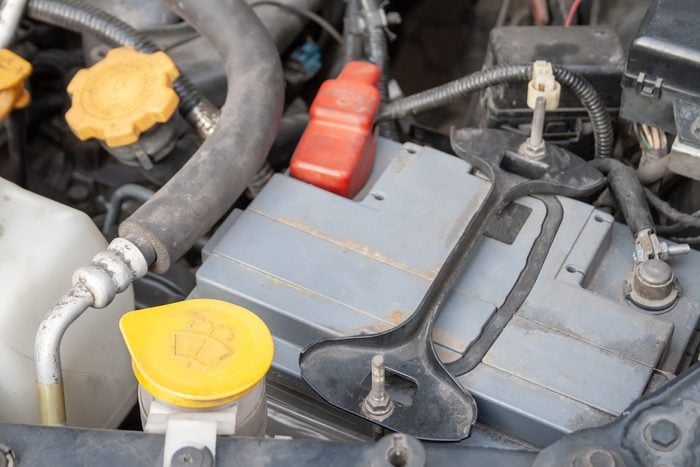
About the expert
Jon Stull spent 19 years as a Ford technician and eight years in the heady equipment repair industry. An ASE master technician for 27 years, Stull is now Pennsylvania Department of Education (PDE) certified automotive technology instructor, preparing the next generation of automotive service professionals.
Tools Required
- Battery memory saver
- Battery terminal cleaning tool or sandpaper
- DVOM
- Hacksaw
- Old toothbrush or stiff non-metallic brush
- Safety glasses
- Slip joint pliers
- Socket/ratchet set
- Utility knife
- Wire brush
- Work gloves
- Wrench set
Materials Required
- Baking soda or spray battery cleaner
- Battery cable terminals - compression terminal made from tinned copper preferred
- Battery terminal anti-corrosion washers
- Battery terminal covers (if missing)
- Battery terminal protective spray
- Blow-dryer or heat gun
- Bucket of clean water or garden hose
- Disposable container
- Disposal shop or paper towels
- Distiller water
- Heat-shrink tubing
- Vaseline or dielectric grease
Project step-by-step (8)
Connect battery memory saver for backup
Don’t skip this step. A battery memory saver supplies current to avoid erasing the computer, radio, keyless entry and clock memory settings. It will also save other critical data, including engine monitor status that will turn on the check engine light.
Here’s how to do it:
- Plug the battery memory saver into your vehicle’s 12V power receptacle.
- For best results, always use a new 9V battery to power the memory saver.
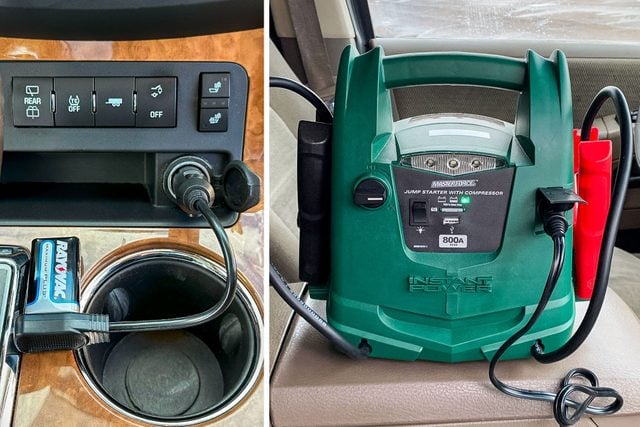
Cleaning the battery
- Mix one tablespoon of baking soda with two cups of hot water in an old, clean plastic cup.
- Remove heavy corrosion from the outside of the terminals with a wire brush.
- Clean the battery case with an old toothbrush and baking soda solution or spray battery cleaner.
- Flush the battery with clean water and wipe dry. Be careful — do not splash the water or cleaning solution on you or other parts of your car.
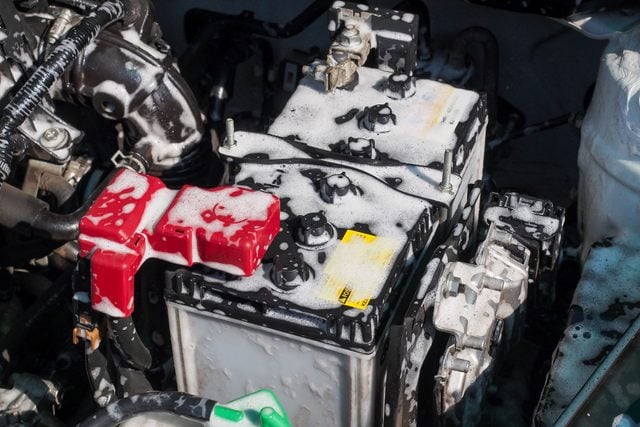
Disconnect the battery terminal clamps
First, determine the positive and negative terminals. Then remove the negative terminal clamp from the battery post first.
- Remove battery terminal protective covers.
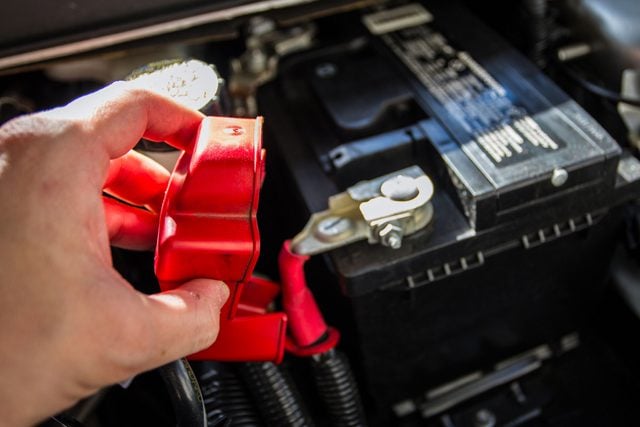
- Loosen the negative (-) terminal clamping bolts with a wrench or socket.
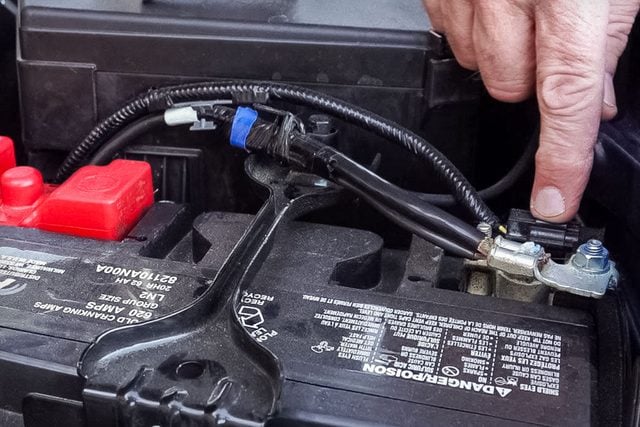
- Disconnect the terminal clamp from the negative (-) battery post.
- Repeat for the positive (+) post.
- Deep clean the posts with a battery terminal cleaning tool or 120-grit sandpaper.
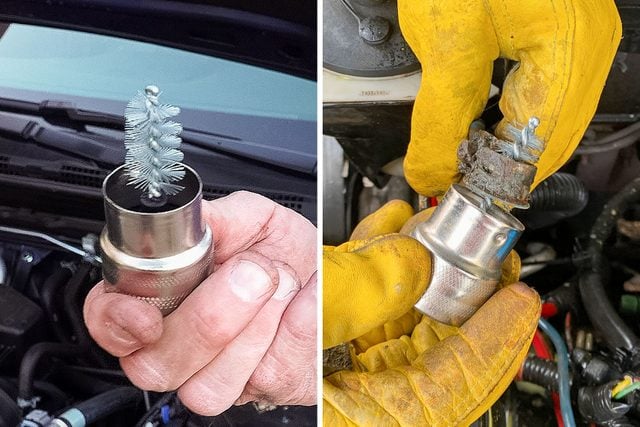
- Clean off any dirt or corrosion from the posts with a damp paper towel.
Battery terminal replacement
- Use the slip-joint pliers to hold the terminal steady.
- Cut the cable flush where it exits the battery terminal with a hack saw. Warning: Do not cut the cable if it’s still connected to the battery!
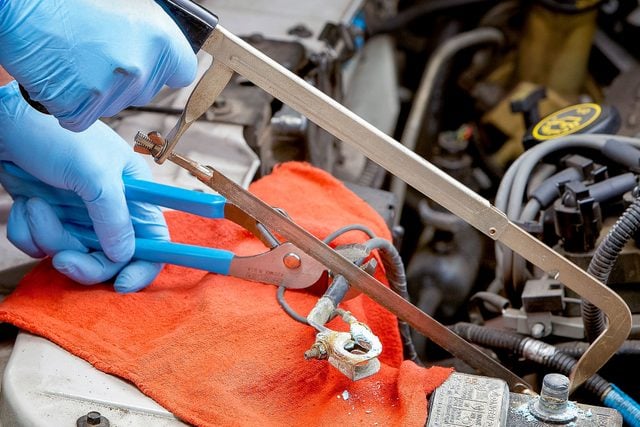
- Cut about 1/2-in. of insulation from each cable with the utility knife. If the copper strands are green, clean them with baking soda/water solution and a wire brush. Dry the cable with compressed air. Spray brake or electronic cleaner if necessary.
- If installing or replacing the battery terminal covers, slide them onto the cable — red for positive, black for negative. Then slide them out of the way.
- Slip the heat shrink tubing onto the cable — again, red for positive and black for negative. Then slide them out of the way.
- Insert the battery cable and any smaller cables through the compression nut.
- The base of the compression nut should bottom out where you trimmed the battery cable insulation. There should be no insulation in the compression nut, only exposed cable.
- While holding the compression fitting with a wrench, rotate/screw the replacement terminal onto the fitting to compress the wire connection.

- Tighten the compression fitting until snug and secure. It’s OK to give it a good yank.
- Slide the heat-shrink tubing over the connection and use a heat gun or hair dryer to shrink it.
- Don’t install the battery terminal covers just yet.
What are battery terminals made of?
Usually lead or a lead composite, and likely plated with copper or zinc. This increases conductivity while protecting them from corrosion.
Are copper compression terminals better than lead?
Yes. Invest in compression replacement battery terminals. They’re made from tinned copper and their compression fitting ensures the terminal makes full 360-degree contact with the cable.
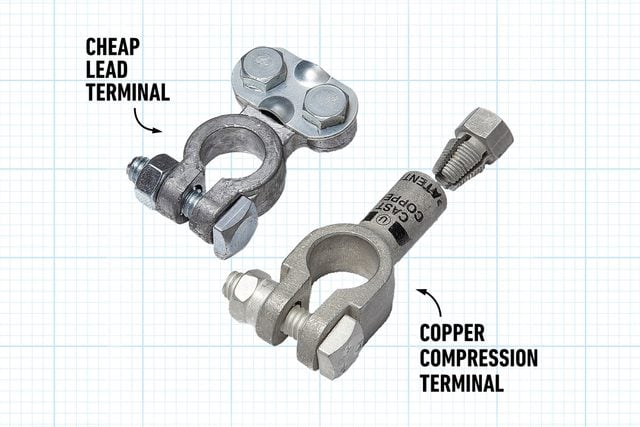
Copper is an excellent conductor of electricity. Typical replacement battery terminals found at your local parts store are made from lead. Worse, the clamp plate (usually made of steel, which corrodes easily) squashes the cable flat, so you only get partial electrical contact.

NOTE: According to the U.S. Environmental Protection Agency (EPA), battery terminal ends made of lead should not be discarded with household garbage or placed in recycling bins. They can be recycled or taken to household hazardous waste collection points.
Apply grease
- Install battery terminal anti-corrosion washers onto the battery posts.
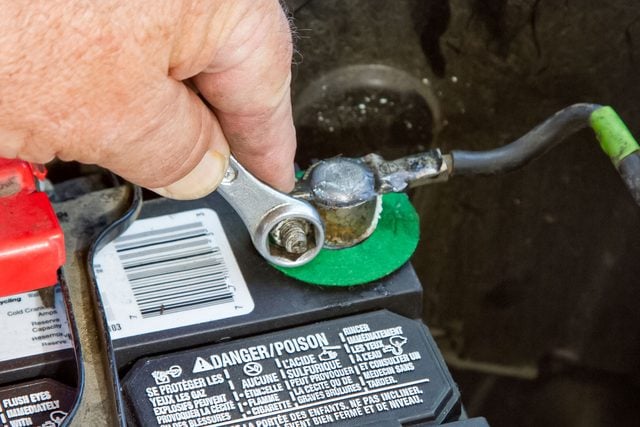
- Coat both battery posts with Vaseline or dielectric grease.

- This lubricates the terminals and protects them from future corrosion.
Install battery terminals
Always connect the positive/red terminal first.
- Push down the terminal clamps onto the post until they touch the top of the battery. In most applications, the top of the post will stick up slightly past the top of the terminal end.
- Securely fasten terminal clamp nuts with a wrench or socket.
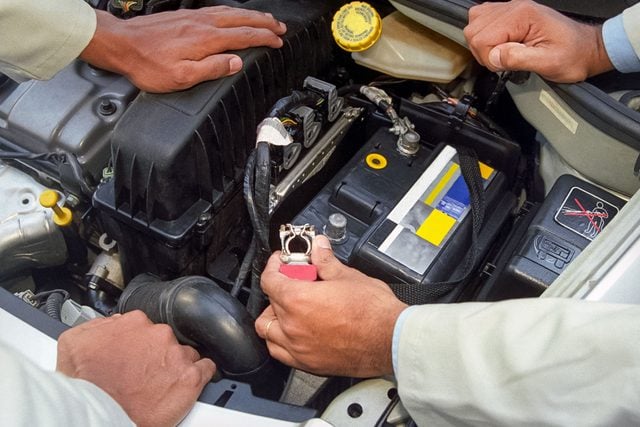
Corrosion prevention
- Before sliding the battery terminal covers onto the terminals, coat both terminals with Vaseline or battery terminal protection grease to prevent corrosion.
- Using the Vaseline or grease gives you more peace of mind and double the protection. And extra protection is never a bad thing.
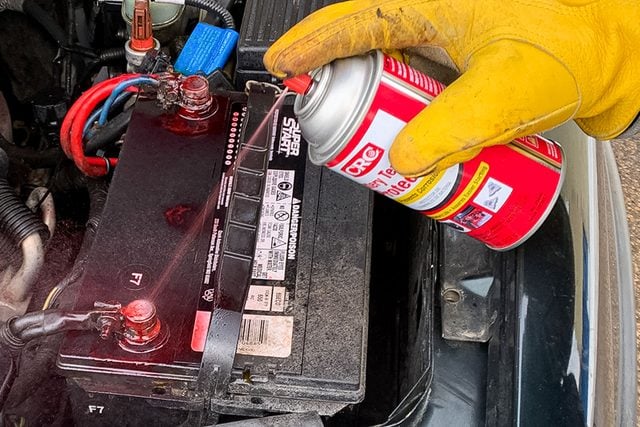
Final steps
Check the battery fluid level if your car has a non-maintenance-free battery. Top off with distilled water if the level is low.
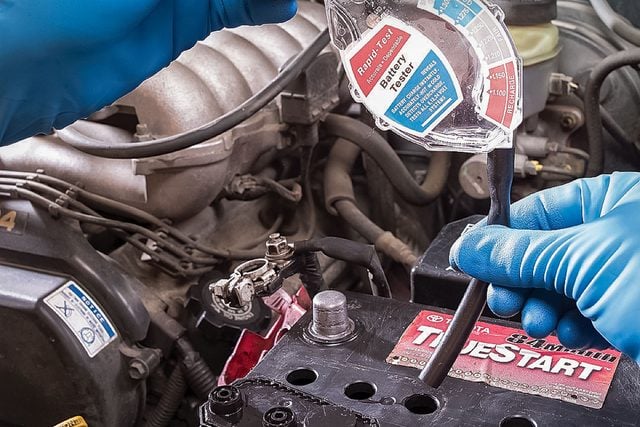
Using a DVOM, be sure the replacement battery terminals have a good, sound electrical connection. Check your DVOM instruction manual to determine where to insert the leads into your meter and run a self-check to ensure your readings are accurate.
How to test battery voltage
- Insert the DVOM’s red test lead into the DVOM’s Volt or Ω (for Omega/Ohms) receptacle.
- Insert the DVOM black test lead into the DVOM’s COM (common ground) receptacle.
- Set the DVOM to 12V DC (direct current).
- Connect the (+) test lead to the (+) battery terminal.
- Connect the (-) test lead to the (-) battery terminal.
- DVOM should display a reading of around 12.6V.
- Reverse the leads; the reading should be negative-12.6V.

- Connect the (+) test lead to the (+) battery post.
- Connect the (-) test lead to the (-) battery post.
- You should see 12.6V.

- Reverse the leads; the reading sound be negative-12.6V.
Voltage drop test
- Set the DVOM to 12V DC (direct current).
- Connect the (-) test lead to the (+) battery terminal.
- Connect the (+) test lead to the (+) battery post.
- If possible, disable the fuel or ignition system to keep the engine from starting.
- Crank the engine.

- Run the same procedure on the negative (-) battery terminal and post.
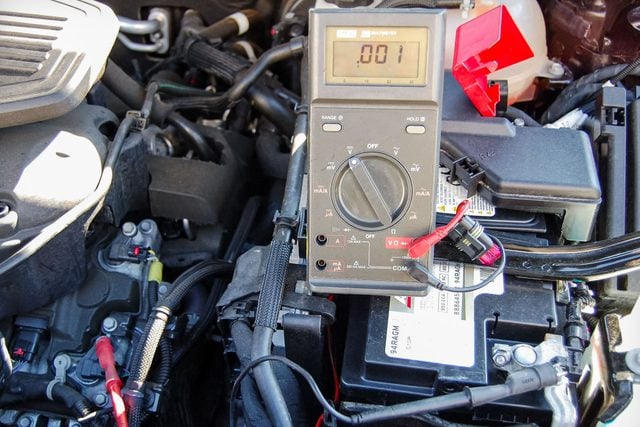
- If the DVOM reads more than .5V while cranking, it indicates high resistance in the electrical connection between the battery terminal and post. This needs to be checked.
Resistance test
- Set the DVOM to the Ω symbol.
- Place the key in the “off” position. Do not start or crank the engine.
- Connect the (-) test lead to one of the battery terminals.
- Connect the (+) test lead to the same battery terminal post.
- DVOM reading should be .000 Ohms. If it’s .002 or less, that’s OK.
- Check the other terminal/post the same way.
- If greater than .005 Ohms, check the connection between the battery terminal and post.
